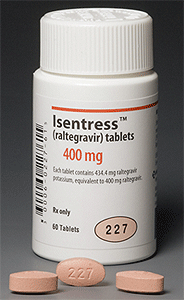Product
Isentress
Approval Date
October 12, 2007
Release Date
October 15, 2007
Company
Merck
Class
Antiretroviral (HIV-1 integrase strand transfer inhibitor)
Indication
HIV-1 infection, in combination with other antiretrovirals, in treatment-experienced adults with evidence of viral replication and HIV-1 strains resistant to multiple antiretrovirals.
Active Ingredient
Raltegravir (as potassium) 400mg; tabs.
Agency Roster
Surge (professional/interactive/education)
Marketing Strategy/Execution
Isentress is the first in a new class of antiretrovirals that inhibits integrase, an enzyme which is vital to the HIV replication process. Merck has estimated that 20,000 to 40,000 US HIV patients qualify to take Isentress, and sales are predicted to reach $20 million in 2007 and $1.1 billion in 2012, according to BernsteinResearch. The product is approved in patients who have stopped responding to at least one drug in each of three available HIV therapy classes. Merck is studying the drug in treatment naïve patients and plans to file for that indication in 2008. However, its twice-daily dosing may well hamper
commercial success in the treatment naïve population, considering the number of once-daily regimes available.
The Market
| HIV antivirals US sales ($000s) last 5 years | |
| 2006 | $5,643,864 |
| 2005 | $5,195,036 |
| 2004 | $4,781,364 |
| 2003 | $4,013,637 |
| 2002 | $3,609,253 |
| Source: IMS Health, Dec. 2007 |
|
| Top 5 HIV antivirals | ||
| Jan.-June ’07 US sales ($000s) | % sales growth over Jan.-June ‘06 | |
| VALTREX (GlaxoSmithKline) | $774,202 | 22% |
| TRUVADA (Gilead) | $431,789 | 6% |
| ATRIPLA (Bristol-Myers Squibb) | $420,599 | *** |
| REYATAZ (Bristol-Myers Squibb) | $331,420 | 19% |
| KALETRA (Abbott) | $285,411 | 5% |
| Source: IMS Health, Dec. 2007 |
||
Physician Outlook
Among the new crop of antiretroviral (ARV) medications which have been recently approved or are in late-stage development, physicians and HIV experts are highly enthusiastic about Merck’s Isentress (Raltegravir/RAL), which was formerly known as MK-0518. Isentress was FDA-approved on October 12 for treatment-experienced HIV/AIDS patients with prior treatment failures. The main drivers of physician excitement about Isentress are its representing a novel ARV class—integrase inhibitors—which prevents HIV from inserting its genetic material into the DNA of the host cell; its high degree of effectiveness in treatment-experienced patients; its favorable tolerability profile, and the fact that (unlike protease inhibitors) it does not require ritonavir-boosting; and its favorable drug interactions profile. The only physician concerns that have been expressed over Isentress relate to its BID dosing, its relatively low genetic mutation barrier and the fact that available clinical trials do not extend longer than 48 weeks. Given Merck’s long-standing commitment to the HIV market sector & community and its well-organized commercial organization, which has marketed both Crixivan (indinavir) and Stocrin (efavirenz) for the past decade, Isentress is likely to see rapid uptake and enjoy widespread usage.
—Noah Pines, executive VP, GfK V2, Dec. 2007
Also in the Pipeline (according to Adis R&D Insight)
No competitor compounds in phase III or pre-registration, US
Recent MM&M Coverage
HIVdrug market to grow, but not for everyone
Merckwill continue DTC for Singulair, Januvia, says CFO
MM&MAll-Stars Company of the Year: Merck
Pharmacology
Raltegravir is an antiviral agent that works by inhibiting the activity of HIV-1 integrase, an enzyme needed for viral replication. Inhibiting this enzyme prevents the integration of linear HIV-1 DNA into the host cell genome, thus preventing the formation of HIV-1 provirus and preventing the propagation of the virus.
Raltegravir may be taken without regard to food. It is metabolized chiefly by uridine diphosphate glucuronosyltransferase 1A1 (UGT1A1) in the liver; a small percentage is excreted unchanged by the kidneys. No dosage adjustment is necessary in patients with renal or hepatic impairment, however, the effect of severe hepatic impairment on the pharmacokinetics of raltegravir has not been studied.
Clinical Trials
Analyses of 24-week data from two ongoing, randomized, double-blind placebo-controlled studies provided evidence for the efficacy of raltegravir. These studies are being conducted in HIV-1 infected, antiretroviral treatment-experienced adults whose infection is resistant to at least one drug in each of the three major classes of antiretroviral agents: non-nucleoside reverse transcriptase inhibitors, nucleoside reverse transcriptase inhibitors, and protease inhibitors. Patients were given either optimized background therapy (OBT) plus raltegravir or OBT plus placebo. Based on the responses of 436 subjects from the pooled studies who had completed 24 weeks of therapy, 75.5% of those given raltegravir had a viral load of <400 copies/mL, compared to 39.3% of those given placebo, and 62.6% of the raltegravir-treated subjects had a viral load of <50 copies/mL, compared to 33.3% of those given placebo. Based on 699 subjects who were randomized and treated (including those without 24-week data), 2.8% were deemed non-responders in the raltegravir-treated group compared to 32.9% in the placebo group. The mean increase in CD4+ cell counts was higher in the groups given raltegravir compared to those in the control groups (89 cells/mm3 compared to 35 cells/mm3).
The safety and efficacy of raltegravir have not been established in treatment-naive adult patients or pediatric patients.
Adverse Reactions
Nausea, headache, diarrhea, pyrexia; others (see literature).
Adults
>16yrs: 400mg twice daily. Avoid dosing before dialysis sessions.
Children
<16 yrs: not recommended.
Precautions
Severe hepatic impairment. Monitor for immune reconstitution syndrome (esp. during initial therapy), myopathy, rhabdomyolysis. Pregnancy (Cat.C). Nursing mothers: not recommended.
Interactions
Antagonized by rifampin, possibly other strong UGT 1A1 inducers. May be potentiated by UGT1A1 inhibitors. Caution with other drugs that can cause myopathy (eg, statins).








